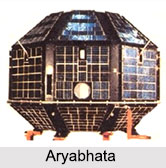 Aryabhata is the first Indian satellite built by India. It was named after Aryabhata I, the prominent ancient Indian astronomer and mathematician of the 5th century AD. The satellite was assembled at Peenya, near Bengaluru but was launched from the erstwhile Soviet Union by a Russian-made rocket on April 19, 1975. The 96.3 minute orbit had an apogee of 619 km and a perigee of 563 km, at an inclination of 50.7 degrees.
Aryabhata is the first Indian satellite built by India. It was named after Aryabhata I, the prominent ancient Indian astronomer and mathematician of the 5th century AD. The satellite was assembled at Peenya, near Bengaluru but was launched from the erstwhile Soviet Union by a Russian-made rocket on April 19, 1975. The 96.3 minute orbit had an apogee of 619 km and a perigee of 563 km, at an inclination of 50.7 degrees.
Naming of Aryabhata
The satellite was named after the Indian mathematician-astronomer Aryabhata (476-550 AD). The 5th Century Indian mathematician and astronomer is best known for explaining the phenomenon of lunar and solar eclipses and for calculating the value of Pi correct to 4 decimal places.
Structure of Aryabhata
Aryabhata weighed 360 kg. The spacecraft was a 26-sided polygon 1.4 m in diameter. All faces (except the top and bottom) were covered with solar cells which generated electricity for the satellite`s 46W power supply system. A power failure halted experiments after 4 days in orbit. All signals from the spacecraft were lost after 5 days of operation. The satellite re-entered the Earth"s atmosphere on 11 February 1992.
Purpose of Aryabhata
Aryabhata was built by the Indian Space Research Organization (ISRO) to conduct experiments in X-ray astronomy, aeronomics and solar physics. It was instrumented to explore conditions in the Earth"s ionosphere, measure neutrons and gamma rays from the Sun and perform investigations in X-ray astronomy. The scientific instruments had to be switched off during the 5th day in orbit because of a failure in the satellite"s electrical power system. Useful information nevertheless was collected during the five days of its operation.
This article is a stub. You can enrich by adding more information to it. Send your Write Up to content@indianetzone.com



















